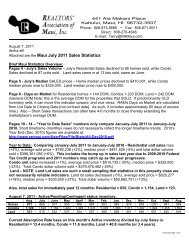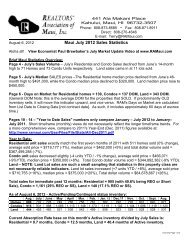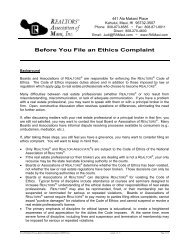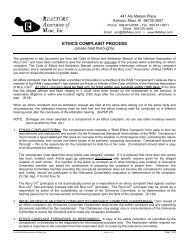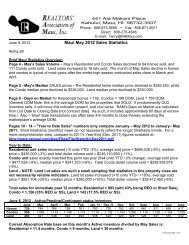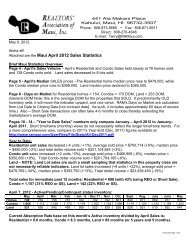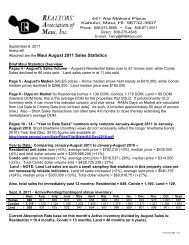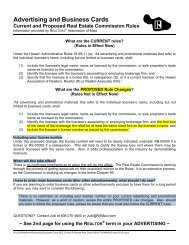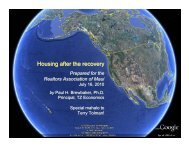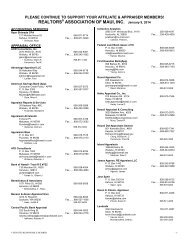October 26, 2012 - REALTORS® Association of Maui, Inc.
October 26, 2012 - REALTORS® Association of Maui, Inc.
October 26, 2012 - REALTORS® Association of Maui, Inc.
Create successful ePaper yourself
Turn your PDF publications into a flip-book with our unique Google optimized e-Paper software.
<strong>October</strong> <strong>26</strong>, <strong>2012</strong><br />
prepared for the<br />
Realtors <strong>Association</strong> <strong>of</strong> <strong>Maui</strong><br />
King Kamehameha Golf Club<br />
by Paul H. Brewbaker, Ph.D.<br />
TZ Economics, Kailua, Hawaii<br />
July 13, <strong>2012</strong><br />
Copyright <strong>2012</strong><br />
Paul H. Brewbaker, Ph.D.
Be careful what you wish for<br />
• In August 2005 I spoke to the Kauai Board <strong>of</strong> Realtors<br />
• I had all new data courtesy <strong>of</strong> Hawaii Information Service, their MLS provider<br />
• I get just as good <strong>Maui</strong> data from Terry Tolman at RAM—good enough to dig deep<br />
• My message on Kauai in 2005: it’s over, you just had your best year, prices are<br />
going to peak in the next 12 months and then you will become the living dead<br />
• Oops!<br />
• Angry Realtor® ladies harangued me from the front row, bracelets jangling:<br />
“but when, when will prices start rising again?!?”<br />
• To quiet them I said: <strong>October</strong> <strong>26</strong>, <strong>2012</strong> ...and they all put it in their Palm Treos<br />
• Oops.<br />
Slide copyright <strong>2012</strong>, TZ Economics<br />
1
Oahu, <strong>Maui</strong> single-family median sales prices: at<br />
quarterly frequency, recovery appears in the last year<br />
800<br />
Quarterly, 000$, s.a. (log scale)<br />
400<br />
<strong>Maui</strong><br />
Oahu<br />
Recessions shaded<br />
200<br />
2000 2002 2004 2006 2008 2010 <strong>2012</strong><br />
Sources:<br />
Slide copyright <strong>2012</strong>, TZ Economics<br />
Realtors <strong>Association</strong> <strong>of</strong> <strong>Maui</strong>, Honolulu Board <strong>of</strong> Realtors; seasonal adjustment and trend extraction by TZE<br />
2
Oahu, <strong>Maui</strong> single-family median sales prices: at<br />
monthly frequency, recovery appears in the last year<br />
800<br />
Monthly, 000$, s.a. (log scale)<br />
400<br />
<strong>Maui</strong><br />
Oahu<br />
Recessions shaded<br />
200<br />
2000 2002 2004 2006 2008 2010 <strong>2012</strong><br />
Sources:<br />
Slide copyright <strong>2012</strong>, TZ Economics<br />
Realtors <strong>Association</strong> <strong>of</strong> <strong>Maui</strong>, Honolulu Board <strong>of</strong> Realtors; seasonal adjustment and trend extraction by TZE<br />
3
<strong>Maui</strong> economic data<br />
Slide copyright <strong>2012</strong>, TZ Economics<br />
4
<strong>Maui</strong> non-agricultural payroll employment (jobs)<br />
75<br />
Monthly, 000, s.a. (log scale)<br />
70<br />
65<br />
60<br />
55<br />
50<br />
45<br />
90 95 00 05 10<br />
Slide copyright <strong>2012</strong>, TZ Economics<br />
Sources: Hawaii DLIR, Hawaii DBEDT; seasonal adjustment and calculation <strong>of</strong> generalized autoregressive conditional<br />
heteroskedasticity annualized standard deviations <strong>of</strong> the log change in payroll employment by TZ Economics<br />
5
Great Recession = beat-down; 9/11 = Black Swan:<br />
<strong>Maui</strong> nonagricultural job count conditional volatility<br />
.07<br />
9/11<br />
.06<br />
91:09<br />
09:11<br />
.05<br />
.04<br />
The Great<br />
Recession<br />
(cluster)<br />
.03<br />
.02<br />
.01<br />
.00<br />
90 95 00 05 10<br />
Slide copyright <strong>2012</strong>, TZ Economics<br />
Sources: Hawaii DLIR, Hawaii DBEDT; seasonal adjustment and calculation <strong>of</strong> generalized autoregressive conditional<br />
heteroskedasticity annualized standard deviations <strong>of</strong> the log change in payroll employment by TZ Economics<br />
6
<strong>Maui</strong> visitor arrivals since the 1980s:<br />
rebuilding from the loss <strong>of</strong> Aloha Airlines, ATA<br />
Thousands, s.a. (log scale)<br />
200<br />
180<br />
Recessions shaded<br />
80<br />
160<br />
40<br />
140<br />
120<br />
9/11<br />
Aloha<br />
Aloha<br />
20<br />
90 95 00 05 10<br />
Domestic<br />
90 95 00 05 10<br />
International<br />
Slide copyright <strong>2012</strong>, TZ Economics<br />
Sources: Hawaii Tourism Authority, Hawaii DBEDT; seasonal adjustment by TZ Economics<br />
7
<strong>Maui</strong> monthly visitor arrivals, seasonally-adjusted<br />
adjusted<br />
220<br />
Recessions shaded<br />
Thousands (log scale)<br />
200<br />
180<br />
160<br />
Aloha<br />
Aloha<br />
140<br />
9/11<br />
00 02 04 06 08 10 12<br />
Slide copyright <strong>2012</strong>, TZ Economics<br />
Sources: Hawaii Tourism Authority, Hawaii DBEDT; seasonal adjustment by TZ Economics<br />
8
<strong>Maui</strong> monthly visitor arrivals and payroll<br />
employment exhibit strong co-movement<br />
Thousands (log scale)<br />
76<br />
72<br />
68<br />
64<br />
60<br />
Visitor arrivals (right scale)<br />
Non-ag jobs (left)<br />
Recessions shaded<br />
9/11<br />
Jobs<br />
Aloha<br />
Aloha<br />
Arrivals<br />
240<br />
220<br />
200<br />
180<br />
160<br />
140<br />
Thousands (log scale)<br />
56<br />
00 02 04 06 08 10 12<br />
Slide copyright <strong>2012</strong>, TZ Economics<br />
Sources: Hawaii DLIR, Tourism Authority, Hawaii DBEDT; seasonal adjustment by TZ Economics<br />
9
<strong>Maui</strong> nonagricultural payroll employment<br />
Thousands (log scale)<br />
Private (right scale)<br />
Public (left)<br />
10.5<br />
10.0<br />
9.5<br />
9.0<br />
8.5<br />
Recession shaded<br />
64<br />
60<br />
56<br />
52<br />
Thousands (log scale)<br />
8.0<br />
02 03 04 05 06 07 08 09 10 11 12<br />
Slide copyright <strong>2012</strong>, TZ Economics<br />
Sources: Hawaii DLIR, Hawaii DBEDT; seasonal adjustment by TZ Economics<br />
10
<strong>Maui</strong> unemployment rate<br />
10<br />
8<br />
Recessions shaded<br />
Aloha<br />
Aloha<br />
Percent, s.a.<br />
6<br />
4<br />
9/11<br />
2<br />
0<br />
00 02 04 06 08 10 12<br />
Slide copyright <strong>2012</strong>, TZ Economics<br />
Source: Bureau <strong>of</strong> Labor Statistics, U.S. Department <strong>of</strong> Labor, Hawaii DLIR, Hawaii DBEDT; data through May <strong>2012</strong>,<br />
seasonal adjustment <strong>of</strong> Hawaii data by TZE<br />
11
U.S. and Hawaii unemployment rates<br />
12<br />
Recessions shaded<br />
Percent, s.a.<br />
10<br />
8<br />
6<br />
4<br />
U.S. average<br />
Neighbor Islands<br />
Oahu<br />
Neighbor Isles<br />
like mainland<br />
2<br />
0<br />
Neighbor Isles<br />
like Oahu<br />
00 02 04 06 08 10 12<br />
Slide copyright <strong>2012</strong>, TZ Economics<br />
Source: Bureau <strong>of</strong> Labor Statistics, U.S. Department <strong>of</strong> Labor, Hawaii DLIR, Hawaii DBEDT; data through May <strong>2012</strong>,<br />
seasonal adjustment <strong>of</strong> Hawaii data by TZE<br />
12
Kauai monthly real nonresidential building permits<br />
100<br />
Recessions shaded<br />
Million 2011 dollars, log scale<br />
10<br />
BOH data<br />
DBEDT data<br />
1<br />
75 80 85 90 95 00 05 10<br />
Sources:<br />
Slide copyright <strong>2012</strong>, TZ Economics<br />
Bank <strong>of</strong> Hawaii, Hawaii DBEDT, U.S. Bureau <strong>of</strong> the Census; deflation and Hodrick-Prescott filter by TZE<br />
13
<strong>Maui</strong> monthly real residential building permit values<br />
Recessions shaded<br />
Million 2011 dollars, log scale<br />
100<br />
10<br />
BOH data<br />
DBEDT data<br />
1<br />
75 80 85 90 95 00 05 10<br />
Sources:<br />
Slide copyright <strong>2012</strong>, TZ Economics<br />
Bank <strong>of</strong> Hawaii, Hawaii DBEDT, U.S. Bureau <strong>of</strong> the Census; deflation and Hodrick-Prescott filter by TZE<br />
14
Quarterly new housing units authorized<br />
by building permit: no glut any time soon<br />
000 units, s.a., log scale<br />
1.0<br />
0.1<br />
Oahu, Hawaii, Kauai (right scale)<br />
<strong>Maui</strong> units (left scale)<br />
Recessions shaded<br />
Recessions shaded<br />
4<br />
3<br />
2<br />
1<br />
0<br />
000 units, s.a., log scale<br />
80 85 90 95 00 05 10 15<br />
Slide copyright <strong>2012</strong>, TZ Economics<br />
Sources:<br />
Bank <strong>of</strong> Hawaii, Hawaii DBEDT; deflation and Hodrick-Prescott filter by TZE<br />
15
<strong>Maui</strong> existing home sales volumes<br />
Recessions shaded<br />
Monthly units, s.a. (log scale)<br />
160<br />
80<br />
40<br />
Condominium<br />
Single-family<br />
00 02 04 06 08 10 12<br />
Slide copyright <strong>2012</strong>, TZ Economics<br />
Sources:<br />
Realtors <strong>Association</strong> <strong>of</strong> <strong>Maui</strong>, Hawaii DBEDT; seasonal adjustment by TZE<br />
16
<strong>Maui</strong> existing home sales volumes<br />
1000<br />
Recessions shaded<br />
Quarterly units, s.a. (log scale)<br />
100<br />
Condominium<br />
Single-family<br />
10<br />
80 85 90 95 00 05 10<br />
Sources:<br />
Slide copyright <strong>2012</strong>, TZ Economics<br />
Realtors <strong>Association</strong> <strong>of</strong> <strong>Maui</strong>, Hawaii DBEDT, UHERO, Prudential Locations; seasonal adjustment by TZE<br />
17
<strong>Maui</strong> existing home sales median prices<br />
800<br />
Recessions shaded<br />
Quarterly units, s.a. (log scale)<br />
400<br />
200<br />
100<br />
Single-family<br />
Condominium<br />
95 00 05 10<br />
Sources:<br />
Slide copyright <strong>2012</strong>, TZ Economics<br />
Realtors <strong>Association</strong> <strong>of</strong> <strong>Maui</strong>, Hawaii DBEDT, UHERO, Prudential Locations; seasonal adjustment by TZE<br />
18
Mythbusters: : the jobless [sic] recovery<br />
Slide copyright <strong>2012</strong>, TZ Economics<br />
19
Honolulu Star-Advertiser (July 14, 2011) http://www.staradvertiser.com/business/20110714__Jobless_recovery_persists_in_Hawaii.html
Nonagricultural payroll recovery:<br />
not fast enough is not the same as not at all<br />
Thousand jobs, s.a. (log scale)<br />
640<br />
620<br />
600<br />
580<br />
560<br />
540<br />
520<br />
P T<br />
Jobless<br />
recovery<br />
2001-2003<br />
U.S. recessions shaded;<br />
Vertical line is 9/11<br />
P T<br />
Up: the new down<br />
2010-<strong>2012</strong><br />
U.S. (right scale)<br />
Hawaii (left)<br />
00 02 04 06 08 10 12<br />
140<br />
136<br />
132<br />
128<br />
124<br />
Million jobs, s.a. (log scale)<br />
Slide copyright <strong>2012</strong>, TZ Economics<br />
Sources: Hawaii DLIR and DBEDT, U.S. Bureau <strong>of</strong> Labor Statistics; national data through May <strong>2012</strong>, seasonal adjustment <strong>of</strong><br />
Hawaii data through April <strong>2012</strong> by TZE<br />
21
Nonagricultural payrolls: Neighbor Islands took a<br />
bigger hit than Oahu, now are slowly re-accelerating<br />
Monthly jobs in 000 (s.a.) log scale<br />
175<br />
170<br />
165<br />
160<br />
155<br />
150<br />
145<br />
U.S. recession shaded<br />
Neighbor<br />
Isles<br />
−10%<br />
P T<br />
Oahu (right scale)<br />
Neighbor Isles (left)<br />
Oahu −5.5%<br />
460<br />
450<br />
440<br />
430<br />
420<br />
410<br />
400<br />
Monthly jobs in 000 (s.a.) log scale<br />
05 06 07 08 09 10 11 12<br />
Slide copyright <strong>2012</strong>, TZ Economics<br />
Sources: Hawaii DLIR, Hawaii DBEDT; seasonal adjustment by TZ Economics<br />
22
Index <strong>of</strong> real GDP: peak quarter = 1.000<br />
U.S. real GDP indexed to cyclical peaks:<br />
recession ended 3 years ago<br />
1.100Previous 10 recessions*<br />
1.050<br />
1.000<br />
0.950<br />
0.900<br />
Great Recession 2008-09<br />
2007Q4<br />
Recession<br />
Recovery<br />
<strong>2012</strong>Q1P<br />
2006 2007 2008 2009 2010 2011 <strong>2012</strong> 2013<br />
*Recessions since World War II—averages aligned to peak quarter <strong>of</strong> each business cycle and to 2007Q4<br />
Slide copyright <strong>2012</strong>, TZ Economics<br />
Source: Pr<strong>of</strong>essor Robert Hall, Stanford University and Chair, NBER Dating Committee; Bureau <strong>of</strong> Economic Analysis,<br />
U.S. Department <strong>of</strong> Commerce; includes <strong>2012</strong>Q1P data and NABE forecasts though 2013Q4<br />
23
Distribution <strong>of</strong> annual U.S. real GDP growth<br />
forecasts in the May <strong>2012</strong> NABE survey<br />
5<br />
Percent change and<br />
geometric mean<br />
5<br />
4<br />
<strong>2012</strong> forecast: 2.37%<br />
4<br />
2013 forecast: 2.68%*<br />
3<br />
3<br />
2<br />
2<br />
1<br />
1<br />
0<br />
0 5 10 15 20<br />
0<br />
0 5 10 15 20<br />
<strong>2012</strong> 2013<br />
Slide copyright <strong>2012</strong>, TZ Economics<br />
Source: National <strong>Association</strong> for Business Economics (public summary at http://www.nabe.com/publib/macsum.html);<br />
histograms and mean calculations by TZE<br />
24
U.S. real GDP growth NABE forecasts May <strong>2012</strong><br />
P T<br />
Percent change, quarterly, annualized<br />
4<br />
0<br />
-4<br />
-8<br />
Recession shaded<br />
Actual<br />
NABE May <strong>2012</strong><br />
Top five forecasts<br />
Bottom five forecasts<br />
06 07 08 09 10 11 12 13 14<br />
Slide copyright <strong>2012</strong>, TZ Economics<br />
Source: BEA (http://www.bea.gov/national/index.htm#gdp); NABE Outlook “Subpar Recovery Exists; Forecasters Expect<br />
Improvement in <strong>2012</strong>,” (May 21, <strong>2012</strong>) (http://www.nabe.com/publib/macsum.html)<br />
25
Federal Reserve core PCE inflation and real GDP<br />
growth rate projections released in June <strong>2012</strong><br />
Central tendencies and ranges FOMC<br />
meeting participants’ projections for PCE<br />
inflation <strong>2012</strong>-14 and over the longer run<br />
Central tendencies and ranges FOMC meeting<br />
participants’ projections for real GDP growth<br />
rate <strong>2012</strong>-14 and over the longer run<br />
Percent Percent<br />
Slide copyright <strong>2012</strong>, TZ Economics<br />
Source: Federal Reserve Board minutes <strong>of</strong> the Federal Open Market Committee meeting June 20, <strong>2012</strong><br />
(http://www.federalreserve.gov/monetarypolicy/files/fomcprojtabl<strong>2012</strong>0620.pdf)<br />
<strong>26</strong>
Federal Reserve economic outlook June <strong>2012</strong>:<br />
2% longer run forecast consistent with policy goal<br />
Slide copyright <strong>2012</strong>, TZ Economics<br />
Source: Federal Reserve Board Members and Federal Reserve Bank Presidents (advance release with FOMC minutes)<br />
(June 20, <strong>2012</strong>) (http://www.federalreserve.gov/monetarypolicy/files/fomcprojtabl<strong>2012</strong>0620.pdf)<br />
27
What the Fed wants to avoid with an explicit inflation<br />
target: misinterpretation <strong>of</strong> inflation risk (like before)<br />
10<br />
January 1994: FOMC begins raising the fed funds target;<br />
no announcement, no forecast, no statement <strong>of</strong> strategy,<br />
markets over-reacted to inflation risk (bond sell-<strong>of</strong>f)<br />
8<br />
6<br />
Percent<br />
4<br />
2<br />
Recession shaded<br />
0<br />
89 90 91 92 93 94 95 96<br />
After the 1990-91 (Gulf War) recession<br />
Slide copyright <strong>2012</strong>, TZ Economics<br />
Source: Federal Reserve Board (http://www.federalreserve.gov/releases/h15/current/)<br />
28
Treasury yields in early-2000s had series <strong>of</strong> “false<br />
starts” before Fed removed monetary policy<br />
accommodation at a “measured pace”<br />
7<br />
Percent<br />
6<br />
5<br />
4<br />
3<br />
2<br />
1<br />
0<br />
Recession shaded<br />
98 99 00 01 02 03 04 05<br />
Even before the Fed<br />
finished easing in<br />
2003, and despite<br />
explicit fed funds<br />
announcements, longterm<br />
bond yields<br />
experienced a bumpy<br />
transition and return to<br />
LR equilibrium as the<br />
Fed removed policy<br />
accommodation,<br />
2004-2006<br />
After the 2001 (dot.com) recession<br />
Slide copyright <strong>2012</strong>, TZ Economics<br />
Source: Federal Reserve Board (http://www.federalreserve.gov/releases/h15/current/)<br />
29
Treasury yields now are guided by explicit statements<br />
<strong>of</strong> Fed policy goals and long-run<br />
equilibria<br />
Percent<br />
6<br />
5<br />
4<br />
3<br />
Recession shaded<br />
QE1<br />
QE21<br />
Operation Twist<br />
Now the Federal Open<br />
Market Committee<br />
(FOMC) tells you their<br />
short-term forecast,<br />
longer-term steadystate<br />
equilibrium<br />
expectations and<br />
policy goals<br />
2<br />
1<br />
0<br />
06 07 08 09 10 11 12 13 14 15 16<br />
Fed funds target rate<br />
trajectory implied by<br />
FOMC participants’<br />
own forecasts<br />
After the 2007-09 Great Recession<br />
Slide copyright <strong>2012</strong>, TZ Economics<br />
Source: Federal Reserve Board (http://www.federalreserve.gov/releases/h15/current/;<br />
http://www.federalreserve.gov/monetarypolicy/files/fomcminutes<strong>2012</strong>0125.pdf)<br />
30
Year-end end fed funds rate forecast distributions<br />
(FOMC, June 20, <strong>2012</strong>) and weighted averages<br />
Percent (in 25 b.p. increments)<br />
5.0<br />
5.0<br />
5.0<br />
5.0<br />
4.0<br />
4.0<br />
4.0<br />
4.0<br />
LR: 4.105%<br />
3.0<br />
3.0<br />
3.0<br />
3.0<br />
2.0<br />
2.0<br />
2.0<br />
2.0<br />
1.0<br />
<strong>2012</strong>: 0.303%<br />
1.0<br />
2013: 0.513%<br />
1.0<br />
2014: 1.105%<br />
1.0<br />
0.0<br />
0 5 10 15<br />
0.0<br />
0 5 10 15<br />
0.0<br />
0 5 10 15<br />
0.0<br />
0 5 10 15<br />
Number <strong>of</strong> forecasts for each rate level in 25 basis point increments (bar length),<br />
and means<br />
Slide copyright <strong>2012</strong>, TZ Economics<br />
Source: Federal Reserve Board (http://www.federalreserve.gov/monetarypolicy/files/fomcminutes<strong>2012</strong>0125.pdf)<br />
31
Nominal and real U.S. Treasury yields<br />
5<br />
Jul 06<br />
4<br />
Jul 07<br />
Jul 08<br />
3<br />
2<br />
Jul 2007<br />
Jul 2006<br />
3<br />
Jul 09<br />
Jul 10<br />
1<br />
Jul 2009<br />
Jul 2008<br />
2<br />
1<br />
Jul 11<br />
June <strong>2012</strong><br />
0<br />
-1<br />
Jul 2010<br />
Jul 2011<br />
June <strong>2012</strong><br />
0<br />
FF<br />
1-yr<br />
2-yr<br />
3-yr<br />
5-yr<br />
7-yr<br />
10-yr<br />
20-yr<br />
30-yr<br />
-2<br />
FF<br />
1-yr<br />
2-yr<br />
3-yr<br />
5-yr<br />
7-yr<br />
10-yr<br />
20-yr<br />
30-yr<br />
U.S. Treasury yield curve<br />
Treasury inflation-protected securities<br />
(TIPS) yield curve<br />
Slide copyright <strong>2012</strong>, TZ Economics<br />
32
Long-term inflation expectations: difference<br />
between nominal and real U.S. Treasury yields<br />
3<br />
Percentage points, difference<br />
between nominal U.S. Treasury<br />
yields and real (TIPS) yields<br />
2<br />
1<br />
0<br />
-1<br />
Jul 06/07/08/11<br />
June <strong>2012</strong><br />
Jul 09/10<br />
Feb 2009<br />
Nov 2008<br />
2.0% PCE<br />
deflator goal<br />
1.2-1.7% PCE<br />
deflator <strong>2012</strong><br />
FOMC forecast<br />
central tendency<br />
-2<br />
FF<br />
1-yr<br />
2-yr<br />
3-yr<br />
5-yr<br />
7-yr<br />
10-yr<br />
20-yr<br />
30-yr<br />
Slide copyright <strong>2012</strong>, TZ Economics<br />
Source: Federal Reserve Board (H.15 constant maturity yields); calculations by TZE through June <strong>2012</strong>, inflation risk<br />
premium is 15-20 b.p. (See http://www.federalreserve.gov/pubs/feds/<strong>2012</strong>/<strong>2012</strong>06/<strong>2012</strong>06pap.pdf)<br />
33
Still waiting for the double-dip?<br />
dip?<br />
Slide copyright <strong>2012</strong>, TZ Economics<br />
34
Spring (May) 2011: double-dip dip headlines keep<br />
double-dip dip recession fears alive and investors scared<br />
Slide copyright <strong>2012</strong>, TZ Economics<br />
Sources: web sites as illustrated (all from the end <strong>of</strong> May 2011)<br />
35
“Overshooting” models <strong>of</strong> asset price dynamics<br />
Simulated asset price dynamics in<br />
a model <strong>of</strong> “slow-moving capital”<br />
P t<br />
Sound effect:<br />
“boy-yoy-yoy-yoy-yoing”<br />
P 0<br />
P T<br />
t 0<br />
Time<br />
“The key implication is that supply or demand shocks must be<br />
absorbed on short notice by a limited set <strong>of</strong> investors. The risk<br />
aversion or limited capital <strong>of</strong> the currently available investors,<br />
including intermediaries, leads them to require a price concession in<br />
order to absorb the supply or demand shock. They plan to ‘lay <strong>of</strong>f’<br />
the associated risk over time as other investors become available.<br />
As a result, the initial price impact is followed by a price reversal that<br />
may occur over an extended period <strong>of</strong> time.”<br />
Simulated asset price dynamics in<br />
a logistic growth model<br />
Slide copyright <strong>2012</strong>, TZ Economics<br />
Sources: Darrell Duffie, “Asset Price Dynamics with Slow-Moving Capital” Journal <strong>of</strong> Finance vol. 65 no. 4 (August 2010) pp 1239-<br />
1<strong>26</strong>7 (http://www.darrellduffie.com/uploads/pubs/DuffieAFAPresidentialAddress2010.pdf); TZ Economics calculations<br />
36
S&P 500 Index: overshooting + oscillation after<br />
Congressional FAIL (Aug. 3, 2011; Nov. 23, 2011)<br />
1500<br />
1400<br />
1941-43 = 10 (log scale)<br />
1300<br />
1200<br />
1100<br />
Supercommittee FAIL<br />
Trading range prior to<br />
the August 3, 2011<br />
federal debt ceiling<br />
“deadline”<br />
1000<br />
Overshooting + oscillation<br />
after Aug. 3, 2011* FAIL <strong>of</strong><br />
Congress to commit to<br />
long-term deficit reduction<br />
11:1 11:2 11:3 11:4 12:1 12:2<br />
*Federal debt ceiling “deadline”<br />
Slide copyright <strong>2012</strong>, TZ Economics<br />
Sources: Standard & Poor’s, Federal Reserve Bank <strong>of</strong> St. Louis; daily closing data through June 21, <strong>2012</strong><br />
37
S&P Case-Shiller<br />
price indexes (“relative(<br />
to Jan 2000”):<br />
“double-dip” is overshooting + oscillation<br />
P T<br />
January 2000 = 100, s.a., log scale<br />
200<br />
100<br />
Denver<br />
Los Angeles<br />
San Diego<br />
San Francisco<br />
Denver (relatively stable)<br />
Phoenix<br />
Las Vegas<br />
U.S. recession shaded<br />
2006 2007 2008 2009 2010 2011 <strong>2012</strong><br />
Slide copyright <strong>2012</strong>, TZ Economics<br />
Sources: Standard & Poor’s; seasonal adjustment using Census X-12 filter by TZ Economics<br />
38
Median CA existing single-family home prices:<br />
“double-dip” or “overshooting + oscillation?”<br />
Quarterly, thousand $, s.a. (log scale)<br />
900<br />
800<br />
700<br />
600<br />
500<br />
400<br />
300<br />
U.S. recession shaded<br />
P T<br />
Oahu (Honolulu) its own private Idaho<br />
San Jose, Sunnyvale, Santa Clara<br />
Anaheim, Santa Ana, Irvine<br />
San Francisco, Oakland, Fremont<br />
San Diego, Carlsbad, San Marcos<br />
Los Angeles, Long Beach, Santa Ana<br />
05 06 07 08 09 10 11 12 13<br />
Slide copyright <strong>2012</strong>, TZ Economics<br />
Sources: Honolulu Board <strong>of</strong> Realtors, National <strong>Association</strong> <strong>of</strong> Realtors; seasonal adjustment by TZE using Census X-12<br />
ARIMA filter, data through first quarter <strong>2012</strong><br />
39
Oahu housing market most stable—relatively<br />
relatively—<strong>of</strong><br />
Hawaii Islands and many mainland urban markets<br />
800<br />
700<br />
600<br />
Oahu<br />
800<br />
700<br />
600<br />
Orange Co., CA<br />
500<br />
500<br />
400<br />
800<br />
05 06 07 08 09 10 11 12<br />
400<br />
800<br />
05 06 07 08 09 10 11 12<br />
700<br />
700<br />
600<br />
500<br />
<strong>Maui</strong><br />
600<br />
500<br />
Kauai<br />
400<br />
05 06 07 08 09 10 11 12<br />
Slide copyright <strong>2012</strong>, TZ Economics<br />
Sources: Honolulu Board <strong>of</strong> Realtors, Realtors <strong>Association</strong> <strong>of</strong> <strong>Maui</strong>, National <strong>Association</strong> <strong>of</strong> Realtors, Kauai Board <strong>of</strong><br />
Realtors / Hawaii Information Service; seasonal adjustment by TZE using Census X-12 ARIMA filter<br />
400<br />
05 06 07 08 09 10 11 12<br />
40
Oahu median single-family home prices returning to<br />
the upper end <strong>of</strong> “the zone,” 2005-<strong>2012</strong><br />
<strong>2012</strong><br />
700<br />
600<br />
Thousand dollars, log scale<br />
500<br />
400<br />
300<br />
92 94 96 98 00 02 04 06 08 10 12<br />
Slide copyright <strong>2012</strong>, TZ Economics<br />
Sources: Honolulu Board <strong>of</strong> Realtors; TZ Economics<br />
41
Unraveling <strong>of</strong> median single-family home prices on<br />
two Neighbor Islands: that was the bottom<br />
Quarterly, thousand $, s.a. (log scale)<br />
800<br />
700<br />
600<br />
500<br />
400<br />
U.S. recession shaded<br />
<strong>Maui</strong><br />
Kauai<br />
Kauai*<br />
<strong>Maui</strong><br />
05 06 07 08 09 10 11 12 13<br />
*April-May <strong>2012</strong><br />
Slide copyright <strong>2012</strong>, TZ Economics<br />
Sources: Realtors <strong>Association</strong> <strong>of</strong> <strong>Maui</strong>, Hawaii Information Service; seasonal adjustment by TZE using Census X-12<br />
ARIMA filter<br />
42
Three relevant trade-<strong>of</strong>fs: inverse relationships<br />
between three pairs <strong>of</strong> variables provide guidance<br />
Honolulu inflation vs. unemployment<br />
• “Supply shocks” from recent energy impulses (Arab Spring, Japan seismic shock),<br />
unemployment falling from over 6.5% to 5.5%, while core inflation rebounds from<br />
near zero to 2% (plus energy boost), consistent with historical recovery transitions<br />
Real hotel room rate appreciation vs. hotel vacancy rates (1 minus occupancy)<br />
• Consistent with historical pattern, breakout above 73% occupancy from below<br />
implies return to real rates <strong>of</strong> appreciation, rising real yields<br />
Rates <strong>of</strong> home price appreciation vs. months <strong>of</strong> MLS inventory remaining<br />
• Transition from 12 months (2008) to 4 months (<strong>2012</strong>) remaining implies an<br />
acceleration <strong>of</strong> home price increase this year to range <strong>of</strong> 5-10%, rising<br />
Slide copyright <strong>2012</strong>, TZ Economics<br />
43
Trade-<strong>of</strong>fs, 1976-2011, between Hawaii inflation and<br />
unemployment (and Fed’s s target inflation zone)<br />
Hawaii’s<br />
Phillips Curve<br />
12<br />
8<br />
With oil and other supply shocks (1974, 1979),<br />
and high “unanchored” inflation expectations<br />
Inflation (%)<br />
4<br />
FOMC goal: 2%<br />
PCE inflation<br />
0<br />
Trade-<strong>of</strong>f 1983-1998<br />
-4<br />
Forecast<br />
Trade-<strong>of</strong>f since 1998<br />
0 2 4 6 8 10<br />
Unemployment (%)<br />
Slide copyright <strong>2012</strong>, TZ Economics<br />
Source: Bureau <strong>of</strong> Labor Statistics, U.S. Department <strong>of</strong> Labor, Hawaii DBEDT and DLIR; all calculations by TZE<br />
44
Recent events: supply shocks since the recession<br />
Oahu inflation and unemployment data, 1998-2011<br />
Inflation (%)<br />
pˆ<br />
t<br />
8<br />
6<br />
2006<br />
Assumed long-term nonaccelerating<br />
inflation<br />
equilibrium:<br />
*<br />
( pˆ<br />
)<br />
* t , ut<br />
4<br />
2007<br />
2008<br />
2011<br />
*<br />
ˆ t p<br />
2<br />
2010<br />
Post-recession petroleum<br />
inflation, financial frictions<br />
(Hawaii Clean Energy Policy?)<br />
0<br />
2009<br />
-2<br />
1998<br />
1 2 3 4 5 6 7<br />
Unemployment (%)<br />
*<br />
u t<br />
u t<br />
Slide copyright <strong>2012</strong>, TZ Economics<br />
Source: Bureau <strong>of</strong> Labor Statistics, US Department <strong>of</strong> Labor; calculations by TZE<br />
45
Low-sulfur petroleum price benchmark:<br />
North Sea (Europe) Brent crude oil<br />
160<br />
P T<br />
Monthly, dollars/barrel (log scale)<br />
80<br />
40<br />
U.S. recession shaded<br />
05 06 07 08 09 10 11 12<br />
Slide copyright <strong>2012</strong>, TZ Economics<br />
Sources: Federal Reserve Bank <strong>of</strong> St. Louis<br />
(http://research.stlouisfed.org/fred2/series/MCOILWTICO/downloaddata?cid=32217)<br />
46
Historical quarterly trade-<strong>of</strong>fs, 1978-2011,<br />
between Hawaii hotel room real rate<br />
movements and hotel vacancy rates<br />
15<br />
Real room rate changes (% y-o-y)<br />
10<br />
5<br />
0<br />
-5<br />
-10<br />
-15<br />
.10 .15 .20 .25 .30 .35 .40 .45<br />
Think <strong>of</strong> it as a trade-<strong>of</strong>f between<br />
appreciation (in real room rates)<br />
and unemployment (<strong>of</strong> hotel rooms)<br />
Hotel vacancy rate (%)<br />
Slide copyright <strong>2012</strong>, TZ Economics<br />
Sources: Hospitality Advisors LLC, Hawaii DBEDT, U.S. Bureau <strong>of</strong> Labor Statistics; regression by TZE<br />
47
Hawaii hotel room real rates and vacancy:<br />
more aggressive yield recapture in last few years<br />
15<br />
Realroom ratechanges(%y-o-y)<br />
10<br />
end-2011<br />
5<br />
0<br />
-5<br />
-10<br />
2009Q3<br />
-15<br />
.10 .15 .20 .25 .30 .35 .40 .45<br />
Hotel vacancy rate (%)<br />
Slide copyright <strong>2012</strong>, TZ Economics<br />
Sources: Hospitality Advisors LLC, Hawaii DBEDT, U.S. Bureau <strong>of</strong> Labor Statistics; regression by TZE<br />
48
Trade-<strong>of</strong>fs, 1994-2011, between Oahu SF home price<br />
movements and months <strong>of</strong> inventory remaining<br />
The Sklarz Curve<br />
% change P(single-family)<br />
40<br />
30<br />
20<br />
10<br />
0<br />
-10<br />
Again, think <strong>of</strong> it as a trade-<strong>of</strong>f<br />
between inflation (in home prices)<br />
and unemployment (<strong>of</strong> houses)<br />
Shaded intersection: <strong>2012</strong> forecast<br />
-20<br />
0 4 8 12 16 20 24<br />
Months <strong>of</strong> inventory (-5)<br />
Slide copyright <strong>2012</strong>, TZ Economics<br />
Sources: Honolulu Board <strong>of</strong> Realtors; regression by TZE as anticipated in as anticipated in Norm Miller and Mike Sklarz,<br />
“A Note on Leading Indicators <strong>of</strong> House Price Trends,” Journal <strong>of</strong> Real Estate Research 1:1 (Fall 1986) pp. 99-109<br />
49
Trade-<strong>of</strong>fs between Oahu SF prices and inventory<br />
remaining: you just missed the first year<br />
%change P(single-family)<br />
40<br />
30<br />
20<br />
10<br />
0<br />
-10<br />
Spring <strong>2012</strong><br />
Summer 2009<br />
Brewbaker says the<br />
recession is over?<br />
-20<br />
0 4 8 12 16 20 24<br />
Summer 2011<br />
“Double dip” fetishism<br />
Months <strong>of</strong> inventory (-5)<br />
Slide copyright <strong>2012</strong>, TZ Economics<br />
Sources: Honolulu Board <strong>of</strong> Realtors; regression by TZE as anticipated in as anticipated in Norm Miller and Mike Sklarz,<br />
“A Note on Leading Indicators <strong>of</strong> House Price Trends,” Journal <strong>of</strong> Real Estate Research 1:1 (Fall 1986) pp. 99-109<br />
50
The Sklarz Curve during the last housing<br />
cycle—trough to trough (1999-2011)<br />
40<br />
40<br />
%chng P(single-family) y-o-y<br />
30<br />
20<br />
10<br />
0<br />
-10<br />
Single-family<br />
%chng P(condominium) y-o-y<br />
30<br />
20<br />
10<br />
0<br />
-10<br />
Condominium<br />
-20<br />
0 4 8 12 16<br />
-20<br />
0 4 8 12 16<br />
Months <strong>of</strong> inventory remaining (-5)<br />
Months <strong>of</strong> inventory remaining (-5)<br />
Slide copyright <strong>2012</strong>, TZ Economics<br />
Source: Honolulu Board <strong>of</strong> Realtors (raw data); seasonal adjustment using Census X-12 ARIMA filter, regressions on<br />
natural log <strong>of</strong> months <strong>of</strong> inventory remaining (lagged 5 months) by TZE through April <strong>2012</strong><br />
51
<strong>Maui</strong> single-family home days on market<br />
200<br />
Recessions shaded<br />
180<br />
160<br />
Days<br />
140<br />
120<br />
100<br />
80<br />
2000 2002 2004 2006 2008 2010 <strong>2012</strong><br />
Slide copyright <strong>2012</strong>, TZ Economics<br />
Source: Realtors <strong>Association</strong> <strong>of</strong> <strong>Maui</strong><br />
52
<strong>Maui</strong> SF days on market seasonality (right)<br />
and underlying trend (left); data through June <strong>2012</strong><br />
200<br />
180<br />
1.2<br />
160<br />
1.1<br />
140<br />
120<br />
1.0<br />
100<br />
0.9<br />
80<br />
2000 2002 2004 2006 2008 2010 <strong>2012</strong><br />
<strong>Maui</strong> single-family days on market (s.a.)<br />
and underlying trend through April<br />
00 01 02 03 04 05 06 07 08 09 10 11 12<br />
<strong>Maui</strong> single-family days on market<br />
seasonal adjustment factors (avg. = 1)<br />
Slide copyright <strong>2012</strong>, TZ Economics<br />
Source: Realtors <strong>Association</strong> <strong>of</strong> <strong>Maui</strong>; seasonal adjustment by TZE<br />
53
Sklarz Curve, RAM version: use “days on market”<br />
60<br />
Single-family pricechange (%)<br />
40<br />
20<br />
0<br />
-20<br />
Prices rising<br />
Prices falling<br />
-40<br />
80 100 120 140 160 180 200<br />
Days on market (trend) (-5 months)<br />
Slide copyright <strong>2012</strong>, TZ Economics<br />
Source: Realtors <strong>Association</strong> <strong>of</strong> <strong>Maui</strong>; regression by TZE<br />
54
Toxicity: learning from mortgage delinquency<br />
• The Great Recession, concluding the sub-prime mortgage lending-driven housing<br />
“bubble” that preceded it, had legacy <strong>of</strong> wide geographic delinquency variation<br />
• Great Recession notable for anomalous spike in serious delinquency<br />
• Setting up a comparison: house price movements, delinquency changes<br />
Slide copyright <strong>2012</strong>, TZ Economics<br />
55
U.S. delinquency rate on single-family residential<br />
mortgages, domestic <strong>of</strong>fices <strong>of</strong> commercial banks<br />
12<br />
Recessions shaded<br />
10<br />
Percent, s.a.<br />
8<br />
6<br />
4<br />
2<br />
0<br />
1995 2000 2005 2010<br />
Slide copyright <strong>2012</strong>, TZ Economics<br />
Source: Federal Reserve Bank <strong>of</strong> St. Louis (http://research.stlouisfed.org/fred2/series/DRSFRMACBS); graphic by TZE<br />
56
Mortgage delinquency rate by county in Hawaii:<br />
first mortgages, home equity loans and lines<br />
14<br />
Percent <strong>of</strong> loans, at year end<br />
12<br />
10<br />
8<br />
6<br />
4<br />
2<br />
Recessions shaded<br />
Big Island<br />
Kauai<br />
<strong>Maui</strong><br />
Oahu<br />
0<br />
2000 2002 2004 2006 2008 2010 <strong>2012</strong><br />
Slide copyright <strong>2012</strong>, TZ Economics<br />
Source: Federal Reserve Bank <strong>of</strong> New York (http://data.newyorkfed.org/creditconditions/); graphic by TZE<br />
57
Hawaii mortgage delinquency rates<br />
4<br />
Percent <strong>of</strong> mortgages outstanding<br />
3<br />
2<br />
1<br />
U.S. recessions shaded<br />
30-59 days delinquent<br />
90+ days delinquent<br />
90+<br />
30+<br />
“Sub-prime”<br />
financial crisis<br />
notable for sharp<br />
increase in<br />
longer-term<br />
mortgage<br />
delinquency<br />
rates<br />
0<br />
1980 1985 1990 1995 2000 2005 2010<br />
Slide copyright <strong>2012</strong>, TZ Economics<br />
Source: Regressions and seasonal adjustment by TZE; data from Mortgage Bankers <strong>Association</strong>, TZE<br />
58
Mortgage delinquency near cyclical peak (2010Q3)<br />
≥90 days past due by county (darker is higher)<br />
22.7 Dade, FL<br />
18.3 Broward, FL<br />
15.9 Palm Beach, FL<br />
15.6 Clark, NV<br />
13.6 Riverside, CA<br />
13.2 San Joaquin<br />
12.8 San Bernadino, CA<br />
11.4 Bronx, NY<br />
10.1 Maricopa, AZ<br />
9.4 Sacramento, CA<br />
9.1 Contra Costa, CA<br />
8.8 Los Angeles, CA<br />
8.2 Hawaii, HI<br />
7.6 <strong>Maui</strong>, HI<br />
7.6 San Diego, HI<br />
6.9 Orange, CA<br />
5.9 Santa Clara, CA<br />
5.3 U.S. average<br />
4.5 Kauai, HI<br />
3.7 San Francisco, CA<br />
3.4 Honolulu, HI<br />
1.8 Dane, WI<br />
1.0 Cherry, NE<br />
0.0 Todd, SD<br />
Slide copyright <strong>2012</strong>, TZ Economics<br />
Sources: Federal Reserve Bank <strong>of</strong> New York based on credit-reporting agency TransUnion LLC’s Trend Data database<br />
(http://data.newyorkfed.org/creditconditionsmap/)<br />
59
Foreclosures as a percent <strong>of</strong> housing units by state<br />
0.333<br />
0.328<br />
0.319<br />
0.309<br />
0.308<br />
0.202 0.294<br />
0.193<br />
0.189<br />
0.169<br />
0.149<br />
0.148<br />
0.134<br />
0.133<br />
0.117<br />
0.115<br />
0.115<br />
0.112<br />
0.112<br />
0.110<br />
0.096<br />
0.093<br />
0.091<br />
0.087<br />
0.085<br />
0.00 0.10 0.20 0.30<br />
Georgia<br />
Arizona<br />
Nevada<br />
California<br />
Illinois<br />
Florida<br />
Ohio<br />
Michigan<br />
South Carolina<br />
Utah<br />
Wisconsin<br />
Colorado<br />
Indiana<br />
Delaware<br />
Idaho<br />
Texas<br />
New<br />
Oregon<br />
Kansas<br />
Minnesota<br />
Iowa<br />
Missouri<br />
Tennessee<br />
Louisiana<br />
Massachusetts<br />
Washington<br />
Kentucky<br />
Virginia<br />
New Mexico<br />
Oklahoma<br />
Pennsylvania<br />
Rhode Island<br />
North<br />
Maryland<br />
Connecticut<br />
Alaska<br />
Alabama<br />
Nebraska<br />
New Jersey<br />
Hawaii<br />
New York<br />
Wyoming<br />
Mississippi<br />
South Dakota<br />
Arkansas<br />
Montana<br />
Maine<br />
West Virginia<br />
North Dakota<br />
Vermont<br />
0.085<br />
0.084<br />
0.084<br />
0.083<br />
0.077<br />
0.077<br />
0.076<br />
0.074<br />
0.073<br />
0.072<br />
0.067<br />
0.066<br />
0.054<br />
0.053<br />
0.051<br />
0.043<br />
0.041<br />
0.037<br />
0.035<br />
0.031<br />
0.029<br />
0.015<br />
0.011<br />
0.007<br />
0.007<br />
Sources: Realty Trac (http://www.realtytrac.com/trendcenter/), data for May <strong>2012</strong>; graphic by TZE<br />
0.00 0.10 0.20 0.30<br />
Slide copyright <strong>2012</strong>, TZ Economics<br />
60
Using trend data: the inverse relationship between<br />
changes in home prices and delinquency rates<br />
appears cyclically in diagonal, flattened orbits<br />
Percent change in single-family prices<br />
25<br />
20<br />
15<br />
10<br />
5<br />
0<br />
-5<br />
-10<br />
2004<br />
1987<br />
1980s<br />
<strong>2012</strong>Q1<br />
1992<br />
1997<br />
2010<br />
1 2 3 4 5 6 7<br />
Delinquent as percent <strong>of</strong> all loans<br />
Prices rising<br />
Prices falling<br />
Slide copyright <strong>2012</strong>, TZ Economics<br />
Data sources: Prudential Locations, UHERO, Mortgage Bankers <strong>Association</strong>, Guy Sakamoto (Bank <strong>of</strong> Hawaii); all<br />
calculations by TZE<br />
61
Digging deeper into linkages:<br />
house price movements and delinquency changes<br />
• Rising prices are associated with falling delinquencies (up to lags, etc.)<br />
• In cyclical markets, rising phase <strong>of</strong> house price cycle has similar inverse<br />
relationship with falling phase <strong>of</strong> mortgage delinquency cycle (up to lags)<br />
• Some evidence that price deceleration raises the pace <strong>of</strong> increase in delinquency<br />
(i.e. prices rising at a decreasing rate <strong>of</strong> increase can precede delinquency rise<br />
• Complex nonlinearity actually masks underlying orbit—embedding inverse<br />
relationship—in delinquency-price change space<br />
Slide copyright <strong>2012</strong>, TZ Economics<br />
62
Trends, cycles and bubbles<br />
• We’ve got all three—simultaneously<br />
• Arbitrage and factor mobility (capital, labor, technology) implies convergence to<br />
common trend in long-run home price appreciation<br />
• Cycles are not bubbles, and presence <strong>of</strong> the former is neither necessary nor<br />
sufficient for the latter<br />
• Hawaii has had more cyclical housing valuations since early-statehood (1960s)<br />
• Many microeconomic factors distinguish regional performance differences even in<br />
shared macroeconomic environment<br />
• Looking for signs <strong>of</strong> cyclical upswing, indications <strong>of</strong> its imminence<br />
• Remember: Hawaii peak for sales 2005, peak for values 2006—six years ago<br />
Slide copyright <strong>2012</strong>, TZ Economics<br />
63
Average Oahu single-family and condominium<br />
existing home sales prices<br />
Thousand dollars, log scale<br />
1000<br />
100<br />
Single-family<br />
Condominium<br />
10<br />
Recessions shaded<br />
1960 1970 1980 1990 2000 2010 2020<br />
Slide copyright <strong>2012</strong>, TZ Economics<br />
Sources: Honolulu Board <strong>of</strong> Realtors; TZ Economics<br />
64
Remarkably, until the sub-primehousing<br />
bubble,<br />
longer-term trends were roughly equivalent<br />
Indexes, s.a. (1987 = 100), logs<br />
400<br />
200<br />
100<br />
Oahu (median prices)<br />
Las Vegas (Case-Shiller)<br />
Regressions <strong>of</strong> the<br />
natural logarithm <strong>of</strong> the<br />
two price indexes on a<br />
constant and a time<br />
trend, Oahu (1980-<br />
2011) and Las Vegas<br />
(1987-2004)<br />
U.S. recessions shaded<br />
50<br />
80 85 90 95 00 05 10<br />
Slide copyright <strong>2012</strong>, TZ Economics<br />
Source: Standard & Poor’s, Honolulu Board <strong>of</strong> Realtors, TZE database; seasonal adjustment using Census X-12 ARIMA<br />
filter and regressions by TZE<br />
65
Bubblicious housing markets like Phoenix<br />
will have to re-establish establish long-term trend<br />
No longer log-linear<br />
S&P Case-Shiller home price index<br />
January 2000 = 100.0 (log scale)<br />
200<br />
100<br />
Bubblicious<br />
Overshoot<br />
Oscillation<br />
?<br />
50<br />
U.S. recessions shaded<br />
1995 2000 2005 2010<br />
Slide copyright <strong>2012</strong>, TZ Economics<br />
Source: Standard & Poor’s (http://www.standardandpoors.com/indices/sp-case-shiller-home-priceindices/en/us/?indexId=spusa-cashpidff--p-us----);<br />
seasonal adjustment by TZE<br />
66
Some longer-term trajectories probably displaced,<br />
but largely unbroken (Hawaii vs. Iowa)<br />
800<br />
Index, 1985Q1 = 100, s.a., log scale<br />
400<br />
200<br />
100<br />
Hawaii<br />
Iowa<br />
Hawaii 1983-2011*<br />
Iowa 1988-2006<br />
Geographic constraints and<br />
regulatory constraints are why<br />
Hawaii has cycles <strong>of</strong> large<br />
amplitude and Iowa doesn’t:<br />
restricting development only<br />
increases the amplitude <strong>of</strong> the<br />
home price valuation cycle<br />
50<br />
75 80 85 90 95 00 05 10 15<br />
*Regressions <strong>of</strong> the natural logarithm <strong>of</strong> individual state FHFA indexes on a time trend<br />
Sources: Federal Housing Finance Agency (http://www.fhfa.gov/Default.aspx?Page=87) from sales prices and<br />
appraisals; seasonal adjustment, index rebasing and regression by TZ Economics<br />
Slide copyright <strong>2012</strong>, TZ Economics<br />
67
Long-term median home price movements: despite<br />
idiosyncrasies, arbitrage constrains co-movement<br />
800<br />
U.S. recessions shaded<br />
Thousand dollars, s.a., logs<br />
400<br />
200<br />
100<br />
Japan<br />
Bubble<br />
<strong>Maui</strong><br />
Oahu<br />
Orange County, CA<br />
50<br />
75 80 85 90 95 00 05 10<br />
Slide copyright <strong>2012</strong>, TZ Economics<br />
Source: Realtors <strong>Association</strong> <strong>of</strong> <strong>Maui</strong>, Honolulu Board <strong>of</strong> Realtors, Prudential Locations, National <strong>Association</strong> <strong>of</strong> Realtors,<br />
TZE database; seasonal adjustment using Census X-12 ARIMA filter by TZE<br />
68
Finally: lessons from “higher-order moments”<br />
• The distribution <strong>of</strong> home prices tells a lot more than one might think.<br />
• A normal, “bell-shaped” home price distribution would be symmetric,<br />
characterized sufficiently by its first and second moments, the mean and the<br />
standard deviation—the mean and median would be equal (symmetry).<br />
• Actual home prices have an asymmetric distribution—”tilted”—with most<br />
transactions clustered around the median price (at which half the transactions are<br />
above and below) and a small number <strong>of</strong> high-end transactions in a long “tail.”<br />
• The “width” or dispersion <strong>of</strong> the distribution is characterized by its second<br />
moment, the standard deviation (graphed relative to the mean).<br />
• The “tilt” <strong>of</strong> the distribution is characterized by its third moment, its skewness<br />
• The density in the “tail” <strong>of</strong> the distribution is characterized by the fourth moment,<br />
kurtosis.<br />
• Home prices are typically skewed, with a long tail (so-called “leptokurtosis”)<br />
• Some evidence (e.g. Kauai) that higher-order moments—skewness, kurtosis—<br />
rise in the transition from stable to robust home price upward movement.<br />
Slide copyright <strong>2012</strong>, TZ Economics<br />
69
From the Kauai single-family data set:<br />
measures <strong>of</strong> central tendency, including the first moment <strong>of</strong><br />
the distribution <strong>of</strong> existing home sales prices<br />
Recessions shaded<br />
Thousand dollars, log scale<br />
800<br />
400<br />
200<br />
Mean (first moment)<br />
Median<br />
90 95 00 05 10 15<br />
Slide copyright <strong>2012</strong>, TZ Economics<br />
Source: Hawaii Information Service, West Hawaii and Hawaii Island Boards <strong>of</strong> Realtors; moment metrics calculated by TZE<br />
70
From the West Hawaii (Kona) single-family data set:<br />
measures <strong>of</strong> central tendency, including the first moment <strong>of</strong><br />
the distribution <strong>of</strong> existing home sales prices<br />
Thousand dollars, log scale<br />
800<br />
400<br />
200<br />
Mean (first moment)<br />
Median<br />
Recessions shaded<br />
90 95 00 05 10<br />
Slide copyright <strong>2012</strong>, TZ Economics<br />
Source: Hawaii Information Service, Kauai Board <strong>of</strong> Realtors; moment metrics calculated by TZE<br />
71
From the <strong>Maui</strong> single-family data set:<br />
measures <strong>of</strong> central tendency, including the first moment <strong>of</strong><br />
the distribution <strong>of</strong> existing home sales prices<br />
Thousand dollars, log scale<br />
800<br />
400<br />
200<br />
Mean (first moment)<br />
Median<br />
Recessions shaded<br />
1990 1995 2000 2005 2010 2015<br />
Slide copyright <strong>2012</strong>, TZ Economics<br />
Source: Realtors <strong>Association</strong> <strong>of</strong> <strong>Maui</strong>, moment metrics calculated by TZE<br />
72
From the West Hawaii (Kona) single-family data set:<br />
higher order moments <strong>of</strong> the distribution <strong>of</strong> prices—standard<br />
standard<br />
deviation (second), skewness (third) and kurtosis (fourth)<br />
16<br />
14<br />
Recessions shaded<br />
S.D./mean (x100) (right)<br />
Skewness (left scale)<br />
Kurtosis (right scale)<br />
350<br />
300<br />
12<br />
250<br />
10<br />
200<br />
8<br />
150<br />
6<br />
100<br />
4<br />
50<br />
2<br />
90 95 00 05 10<br />
0<br />
Slide copyright <strong>2012</strong>, TZ Economics<br />
Source: Hawaii Information Service, West Hawaii and Hawaii Island Boards <strong>of</strong> Realtors; moment metrics calculated by TZE<br />
73
From the Kauai single-family data set:<br />
higher order moments <strong>of</strong> the distribution <strong>of</strong> prices—standard<br />
standard<br />
deviation (second), skewness (third) and kurtosis (fourth)<br />
16<br />
14<br />
12<br />
S.D./mean (x100) (right scale)<br />
Skewness (left scale)<br />
Kurtosis (right scale)<br />
Recessions shaded<br />
350<br />
300<br />
250<br />
10<br />
8<br />
6<br />
4<br />
200<br />
150<br />
100<br />
50<br />
2<br />
0<br />
90 95 00 05 10 15<br />
Slide copyright <strong>2012</strong>, TZ Economics<br />
Source: Hawaii Information Service, Kauai Board <strong>of</strong> Realtors; moment metrics calculated by TZE<br />
74
From the <strong>Maui</strong> single-family data set:<br />
higher order moments <strong>of</strong> the distribution <strong>of</strong> prices—standard<br />
standard<br />
deviation (second), skewness (third) and kurtosis (fourth)<br />
14<br />
12<br />
S.D./mean (x100)(right)<br />
Skewness (left scale)<br />
Kurtosis (right scale)<br />
240<br />
200<br />
10<br />
160<br />
8<br />
120<br />
6<br />
80<br />
4<br />
40<br />
2<br />
Recessions shaded<br />
0<br />
1995 2000 2005 2010 2015<br />
Slide copyright <strong>2012</strong>, TZ Economics<br />
Source: Realtors <strong>Association</strong> <strong>of</strong> <strong>Maui</strong>, moment metrics calculated by TZE<br />
75
<strong>October</strong> <strong>26</strong>, <strong>2012</strong><br />
• The same cyclical factors interacting with long-term trends, <strong>of</strong>fshore arbitrage,<br />
and onshore macroeconomic fundamentals mattered in 2005 as in <strong>2012</strong><br />
• Different proportions, different mix, does not change the trend-cycle phenomenon<br />
• Hawaii’s home valuation cycle is rooted in microeconomic constraints on supply<br />
• Macroeconomics drives cyclical timing (frequency) and magnitude (amplitude)<br />
• In 2005 Kauai, <strong>Maui</strong> had reached points beyond which excessive bubbliciousness<br />
set the stage for more severe overshooting and oscillation, subsequently<br />
• <strong>Maui</strong> was not Phoenix, but it also was not Oahu—better than one, not the other<br />
• End <strong>of</strong> last housing cycle is reasonably on track to fulfill the expectation that,<br />
broadly-speaking, the 20-teens will exhibit <strong>Maui</strong> house price appreciation<br />
• If your 12-year old child thinks he or she is a teenager, then <strong>October</strong> <strong>26</strong>, <strong>2012</strong><br />
makes perfect sense as to when the next valuation cycle should emerge<br />
• Don’t wait until 2018 to “have that conversation”<br />
Slide copyright <strong>2012</strong>, TZ Economics<br />
76
Mahalo!<br />
Aloha!<br />
Paul H. Brewbaker, Ph.D.<br />
Principal, Economist<br />
TZ Economics<br />
606 Ululani St.<br />
Kailua, Hawaii 96734-4430<br />
4430<br />
paulbrewbaker@tzeconomics.com<br />
Slide copyright <strong>2012</strong>, TZ Economics<br />
77



